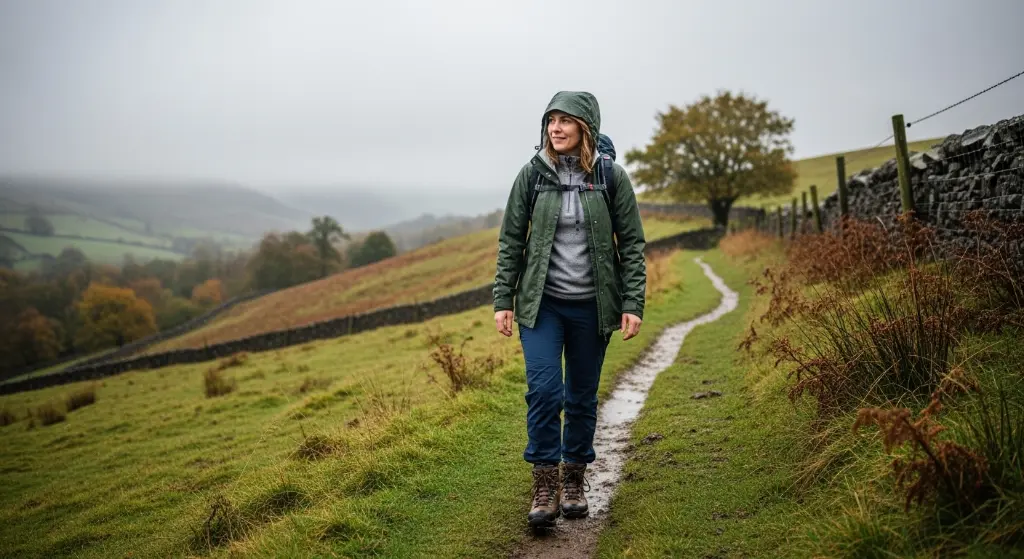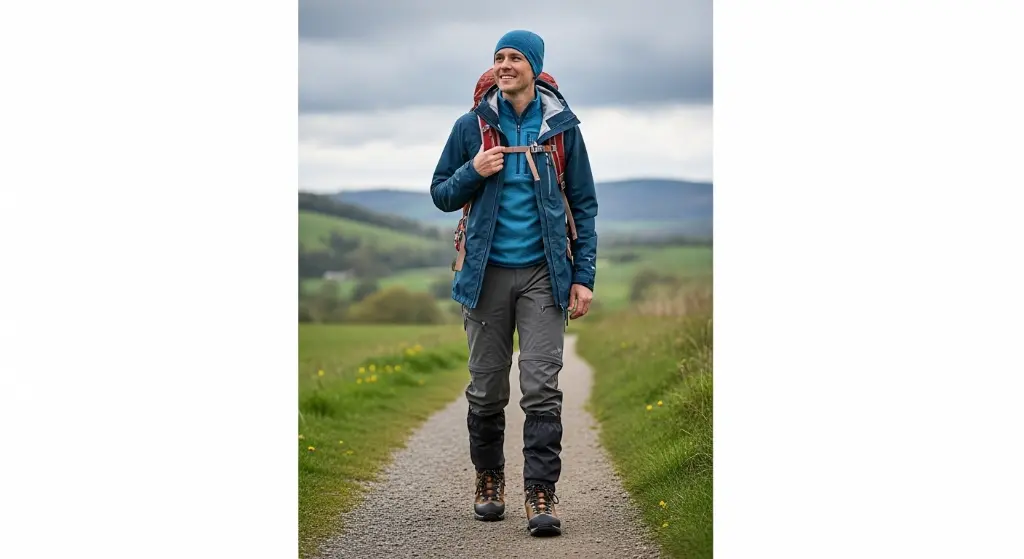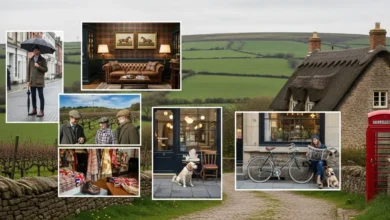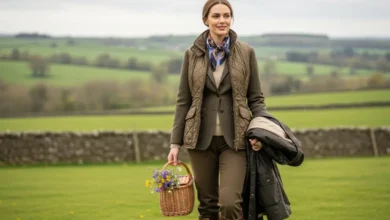Picture it: rolling green hills, ancient stone walls, a crisp breeze carrying the scent of damp earth, and a view that seems to stretch on forever. The UK countryside is a walker’s paradise, but it comes with a famously unpredictable partner: the weather. A glorious morning can dissolve into a sideways drizzle in minutes, turning a pleasant stroll into a soggy ordeal. But as the old adage goes, “There’s no such thing as bad weather, only unsuitable clothing.”
Dressed for the Elements
This guide is your comprehensive answer to the all-important question: what to wear for a country walk in the UK? Forget bulky, awkward outfits; the secret lies in a smart, adaptable system that keeps you comfortable no matter what the sky decides to do.
We’ll break down the essential layering system, explore the non-negotiables like footwear and waterproofs, and provide a handy checklist for every season. By the end, you’ll be ready to stride out with confidence, fully prepared to embrace the breathtaking beauty of the British outdoors.
The Golden Rule: Master the Layering System
If you take only one piece of advice, let it be this: learn to layer. The layering system for hiking is the cornerstone of comfortable walking. Instead of one big, heavy coat, you wear multiple thinner layers that can be added or removed as your body temperature and the weather change. This system traps air between the layers, which is a far more effective insulator than a single thick garment.
See also Tagelmust Berber: The 10-Meter Turban That Represents the Sahara Desert
Tagelmust Berber: The 10-Meter Turban That Represents the Sahara Desert
A typical three-part layering system consists of a base layer, a mid layer, and an outer layer.
1. The Base Layer: Your Second Skin
The base layer sits directly against your skin. Its primary job is not to keep you warm, but to wick moisture (sweat) away from your body. This is critical because wet skin loses heat rapidly, leading to a dangerous chill, even on a mild day.
- What to Wear: Look for tops made from Merino wool or synthetic fabrics (like polyester or polypropylene).
- Why it Works: Merino wool is a natural wonder; it’s breathable, exceptionally good at wicking moisture, and naturally odour-resistant. Synthetics are also excellent at wicking and dry very quickly.
- What to AVOID: Cotton is your enemy. It absorbs moisture like a sponge, clings to your skin, and rapidly draws heat away from your body. A wet cotton t-shirt is a recipe for misery and, in cold conditions, can be genuinely dangerous.
2. The Mid Layer: The Engine of Warmth
This is your insulation layer. Its job is to trap the body heat that the base layer has helped preserve. The versatility of the mid layer is key; you might wear a thick one on a cold day or carry a light one in your pack during summer.
- What to Wear: The most common and effective mid layer is a fleece jacket. Fleeces come in various weights (micro, 100, 200-weight) for different levels of warmth. Other excellent options include lightweight down jackets or synthetic insulated jackets (like PrimaLoft), which offer incredible warmth for their weight.
- Why it Works: These materials are brilliant at trapping warm air in their fibres while remaining breathable, allowing the moisture wicked by your base layer to continue its journey outward.
3. The Outer Layer: Your Shield
Also known as a shell jacket, this layer is your protection from wind and rain. It’s arguably the most crucial piece of your UK hiking gear, as staying dry is paramount.
See also Sampot Chang Kben, Hol, and Phamuong: Unraveling Cambodia’s National Dress 🇰🇭
Sampot Chang Kben, Hol, and Phamuong: Unraveling Cambodia’s National Dress 🇰🇭- What to Wear: A high-quality waterproof and breathable jacket. Look for jackets with taped seams and features like adjustable hoods and cuffs.
- Key Terms to Know:
- Waterproof vs. Water-Resistant: “Water-resistant” or “showerproof” will only hold up in a light, brief drizzle. For the UK, you need “waterproof” for reliable protection.
- Breathability: This is just as important as waterproofing. A breathable fabric (like Gore-Tex, eVent, or a brand’s own proprietary technology) allows water vapour (your sweat) to escape. Without it, you’d get soaked from the inside out, defeating the purpose of the base layer.
Building Your Outfit from the Ground Up
With the layering system understood, let’s assemble the rest of your walking wardrobe from head to toe.

Footwear: Your Most Important Investment
You can get by with an average jacket, but poor footwear will ruin a walk faster than anything else. Your feet carry you for miles over uneven, often muddy terrain. Give them the support and protection they deserve.
Walking Boots or Walking Shoes?
- Walking Shoes: These are like sturdy trainers with better grip. They are great for well-maintained, low-level paths, and dry summer conditions. They offer flexibility but less support.
- Walking Boots: These are the gold standard for most UK country walks. They extend over the ankle, providing crucial support that helps prevent twists and sprains on rocky or uneven ground. Their high-cut design also helps keep water and mud out. For the varied terrain of the UK, a good pair of waterproof walking boots is the most versatile and highly recommended choice.
Don’t Forget the Socks!
Just like your base layer, your socks should be made of Merino wool or a synthetic blend. They will cushion your feet and, most importantly, wick away sweat to help prevent blisters. Again, avoid cotton socks at all costs.
Trousers: Ditch the Denim
Your legs do most of the work, so they need freedom of movement. The right trousers will also offer protection from wind, rain, and scrapes.
- What to Wear: Choose specific walking trousers made from lightweight, quick-drying synthetic material. Many have a bit of stretch, which is excellent for climbing over stiles. “Zip-off” trousers that convert into shorts can be a great, versatile option for changeable days.
- What to AVOID: Jeans are a terrible choice. They are heavy, restrictive, and when they get wet, they stay wet for hours, becoming incredibly cold and uncomfortable.
- Waterproof Overtrousers: These are a non-negotiable item to have in your backpack. Even if the forecast is clear, a sudden downpour can leave you soaked and chilled. A lightweight pair of waterproof overtrousers can be pulled on in seconds and will make a world of difference.
Accessorise for Comfort and Safety
The right accessories complete your outfit and adapt it to the specific conditions of the day.
| Accessory | Why You Need It | Recommended For |
|---|---|---|
| Hat | A warm beanie prevents massive heat loss in winter. A wide-brimmed sun hat protects you from sunstroke in summer. | All seasons (style dependent) |
| Gloves | Essential for keeping hands warm and functional in the cold and wind. Waterproof options are best for wet weather. | Autumn, Winter, Spring |
| Buff/Neck Gaiter | An incredibly versatile tube of fabric. Can be a scarf, headband, hat, or balaclava. Perfect for blocking drafts. | All seasons |
| Sunglasses | Protect your eyes from UV rays and glare, even on hazy or winter days. | All seasons |
| Walking Poles | Reduce strain on your knees (especially downhill), improve balance, and give you an upper-body workout. | Optional, but highly recommended for hilly terrain |
What to Pack: A Seasonal Checklist
Your country walking clothes change with the seasons. Here’s a quick guide to adapting your kit.
Spring / Autumn Walks
These seasons are the most unpredictable. Be prepared for anything.
- Wear: Base layer, lightweight walking trousers, walking boots.
- Pack: Mid-layer fleece, waterproof jacket, waterproof overtrousers, hat, gloves. You can start wearing less and pack more.
Summer Walks
Focus on sun protection and staying cool, but never forget the rain.
- Wear: Synthetic T-shirt (or base layer), lightweight trousers or shorts, sun hat, sunglasses.
- Pack: A very lightweight fleece, a lightweight waterproof jacket, sunscreen. The UK summer is famous for its “sunshine and showers.”
Winter Walks
Warmth and staying dry are your absolute priorities.
- Wear: Thermal base layer (top and bottoms), mid-layer fleece, insulated/waterproof jacket, waterproof trousers, walking boots, warm wool socks, hat, and gloves.
- Pack: An extra fleece or insulated jacket, a flask with a hot drink, a head torch (as daylight is short), and extra snacks.
Ready to Explore

Dressing for a country walk in the UK isn’t about having the most expensive gear; it’s about having the right gear and understanding how to use it. By mastering the layering system and investing in a few key items—especially waterproof boots and a good jacket—you free yourself from worrying about the weather.
You equip yourself to focus on the things that truly matter: the stunning landscapes, the feeling of accomplishment as you reach a summit, and the simple joy of putting one foot in front of the other in the great British outdoors.
So, check the forecast, pack your bag, and get out there. The hills are calling!
Do you have a favourite piece of walking gear you can’t live without? Share your recommendations in the comments below!
Frequently Asked Questions (FAQs)
1. Can I just wear trainers for a country walk?
For short, flat walks on dry, paved paths, you might be okay. However, trainers lack the grip and ankle support needed for uneven, muddy, or rocky terrain. They also offer little water resistance. Proper walking shoes or boots are a much safer and more comfortable choice.
2. Do I really need to buy expensive waterproof trousers?
You don’t need the most expensive pair, but you absolutely need a pair. They are a vital piece of safety equipment. Getting your legs wet on a walk will make you cold and miserable very quickly. A lightweight pair that lives in your backpack is one of the best investments you can make.
3. Why is cotton so bad for walking?
When cotton gets wet (from rain or sweat), it loses all its insulating properties and takes a very long time to dry. This pulls heat away from your body, a process that can lead to hypothermia in cold and wet conditions. Always choose wool or synthetic fabrics instead.
4. Are walking poles worth it?
For many people, yes. Walking poles can significantly reduce the impact on your knees and hips, particularly on long descents. They also improve your stability on tricky ground and can help you power up hills more efficiently. They aren’t essential for everyone, but they are highly beneficial.
5. What should I always have in my backpack, no matter the walk?
Every walker should carry a “ten essentials” kit. This includes:
- Navigation (map and compass, and/or a GPS/phone with a backup power bank)
- Waterproof jacket and trousers
- Extra layer (like a fleece)
- Food and water
- First-aid kit
- Head torch and spare batteries
- Sun protection (hat, glasses, sun cream)
- A fully charged phone
- A whistle for emergencies




